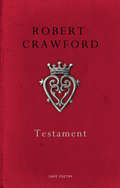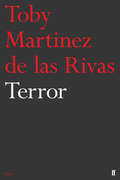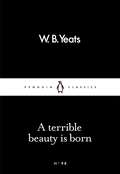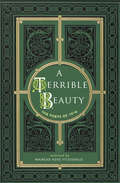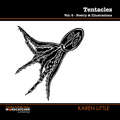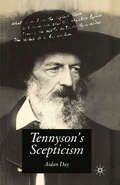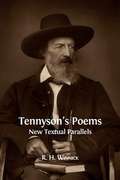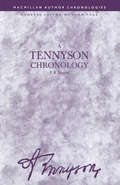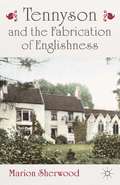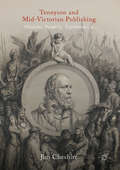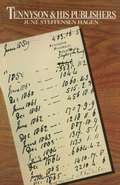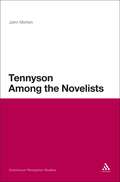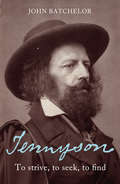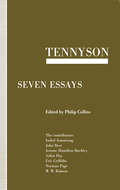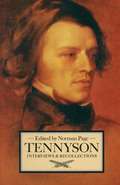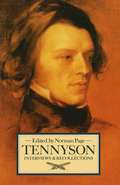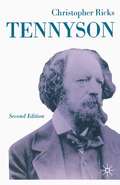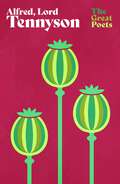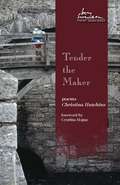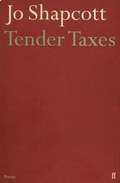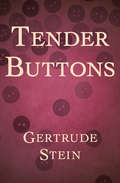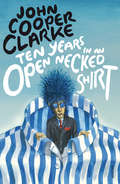- Table View
- List View
Testament: The Old Testament ... - Scholar's Choice Edition
by Robert CrawfordTo make a testament is to attempt to pass on what matters most. In his seventh full-length collection of poems Robert Crawford writes of love, loss, belief, and commitment. Whether in intimate erotic lyrics or in a sustained engagement with the politics of Scottish independence he writes with passion, wit, and assurance about struggles to pass on values and treasures. The book opens with a sequence of love poems, and closes with ‘Testament’, a startlingly fresh gathering of deftly rhymed paraphrases based on the New Testament. Whether making versions of Cavafy or elegising fellow poet Mick Imlah, or writing how a father hands on a piece of marble to his son, Robert Crawford shows in Testament how poetry can communicate from generation to generation aspects of what makes us most vulnerably and engagingly human.
Terror
by Toby Martinez de las RivasIn Terror, Toby Martinez de las Rivas leads us on a high-wire act in pursuit of a new kind of communication. By turns political, social, theological, historical and personal, the poems in this debut collection work closely with the reader, asking questions of us and encouraging us never to settle for inadequate answers. Toby Martinez de las Rivas writes with a flare and a rigour associated with some of his guiding lights: Christopher Smart, Gerard Manley Hopkins, Barry MacSweeney, Geoffrey Hill. Seeking a language which might console us, a language with which we might commune in our most intimate and terrifying moments - be these in love, in doubt, in a prayer for an unborn child, or an exploration of the kind of world we might wish to live in - Terror is a thrilling and powerful debut.
A Terrible Beauty Is Born (Penguin Little Black Classics)
by W. B. Yeats'But I, being poor, have only my dreams; / I have spread my dreams under your feet...'By turns joyful and despairing, some of the twentieth century's greatest verse on fleeting youth, fervent hopes and futile sacrifice.
A Terrible Beauty: Poetry of 1916
by Mairéad Ashe FitzGerald‘A terrible beauty is born’ WB Yeats’s poignant words have come to immortalise the complex legacy of the Easter Rising, 1916. The poetry that emerged at this time of upheaval in Ireland gave voice to the thoughts of a generation. Yeats’s poem, ‘Easter 1916’, sits alongside selected works of other major poets of the era. These include Patrick Pearse, Thomas MacDonagh and Joseph Plunkett, who were executed for their part in the Rising. In the aftermath of the Rising an outpouring of poetry also expressed the shock and grief of literary figures such as Padraic Colum, Francis Ledwidge, Eva Gore-Booth, James Stephens, Dora Sigerson Shorter and Seán O’Casey. Rebels, soldiers, honorary Irishmen, sympathisers and exiles all held up a mirror, in verse, to the events, beliefs and desires bound up in 1916.
Tentacles: Poetry and Illustrations (Creative Portfolio Series #6)
by Karen LittleAn anthology of poems and illustrations by widely published author, Karen Little. For the first time this collection brings together a selection of her poetry and distinctive monochrome illustrations. “Ten poems - ten illustrations - twenty precious jewels, flashing with danger and colour. The poems alone would be worth the price, as would the wild monochrome illustrations. Karen Little is the most exciting voice of this generation, and this collection is (or ought to be!) unmissable. Is Hairless Me Breathless the best poem published this year? Buy this volume, and then when her books are classics and are being studied at universities, you'll be able to show off your first edition, and your impeccable taste. I feel genuinely lucky to be among those 'in the know' about Karen's work now.” - Cathy Bryant is Editor of Best of Manchester Poets and winner of 22 writing awards.
Tennyson's Scepticism
by Aidan DayTennyson is not known for his scepticism. This book argues that he should be. It proposes a revaluation of the way in which his work is read. Tennyson has always been understood as a poet who is committed primarily to endorsing spiritual values. But this study argues that much of his poetry is driven by a metaphysical scepticism that is associated, in part, with rational perspectives deriving from Enlightenment thought. The scepticism in Tennyson's poetry partakes in the complex generation of the modern that was taking place in his era. One of the purposes of the study is to demonstrate that a cultural studies approach to Tennyson trivialises his intellectual subtlety and complexity. Making extensive critical use of Tennyson's manuscript drafts, this study provides close readings of Tennyson's earlier, shorter poems, together with the principal works of his maturity including In Memoriam , Maud and The Lover's Tale , and will be a valuable resource for Tennyson students and scholars worldwide.
Tennyson’s Poems: New Textual Parallels (PDF)
by R. H. WinnickIn Tennyson’s Poems: New Textual Parallels, R. H. Winnick identifies more than a thousand previously unknown instances in which Tennyson phrases of two or three to as many as several words are similar or identical to those occurring in prior works by other hands—discoveries aided by the proliferation of digitized texts and the related development of powerful search tools over the three decades since the most recent major edition of Tennyson’s poems was published. Each of these instances may be deemed an allusion (meant to be recognized as such and pointing, for definable purposes, to a particular antecedent text), an echo (conscious or not, deliberate or not, meant to be noticed or not, meaningful or not), or merely accidental. Unless accidental, Winnick writes, these new textual parallels significantly expand our knowledge both of Tennyson’s reading and of his thematic intentions and artistic technique. Coupled with the thousand-plus textual parallels previously reported by Christopher Ricks and other scholars, he says, they suggest that a fundamental and lifelong aspect of Tennyson’s art was his habit of echoing any work, ancient or modern, which had the potential to enhance the resonance or deepen the meaning of his poems. The new textual parallels Winnick has identified point most often to the King James Bible, and to such canonical authors as Shakespeare, Milton, Dryden, Pope, Thomson, Cowper, Shelley, Byron, and Wordsworth. But they also point to many authors rarely if ever previously cited in Tennyson editions and studies, including Michael Drayton, Richard Blackmore, Isaac Watts, Erasmus Darwin, John Ogilvie, Anna Lætitia Barbauld, Letitia Elizabeth Landon, John Wilson, and—with surprising frequency—Felicia Hemans. Tennyson’s Poems: New Textual Parallels is thus a major new resource for Tennyson scholars and students, an indispensable adjunct to the 1987 edition of Tennyson’s complete poems edited by Christopher Ricks.
Tennyson’s Poems: New Textual Parallels
by R. H. WinnickIn Tennyson’s Poems: New Textual Parallels, R. H. Winnick identifies more than a thousand previously unknown instances in which Tennyson phrases of two or three to as many as several words are similar or identical to those occurring in prior works by other hands—discoveries aided by the proliferation of digitized texts and the related development of powerful search tools over the three decades since the most recent major edition of Tennyson’s poems was published. Each of these instances may be deemed an allusion (meant to be recognized as such and pointing, for definable purposes, to a particular antecedent text), an echo (conscious or not, deliberate or not, meant to be noticed or not, meaningful or not), or merely accidental. Unless accidental, Winnick writes, these new textual parallels significantly expand our knowledge both of Tennyson’s reading and of his thematic intentions and artistic technique. Coupled with the thousand-plus textual parallels previously reported by Christopher Ricks and other scholars, he says, they suggest that a fundamental and lifelong aspect of Tennyson’s art was his habit of echoing any work, ancient or modern, which had the potential to enhance the resonance or deepen the meaning of his poems. The new textual parallels Winnick has identified point most often to the King James Bible and to such canonical authors as Shakespeare, Milton, Dryden, Pope, Thomson, Cowper, Shelley, Byron, and Wordsworth. But they also point to many authors rarely if ever previously cited in Tennyson editions and studies, including Michael Drayton, Richard Blackmore, Isaac Watts, Erasmus Darwin, John Ogilvie, Anna Lætitia Barbauld, Letitia Elizabeth Landon, John Wilson, and—with surprising frequency—Felicia Hemans. Tennyson’s Poems: New Textual Parallels is thus a major new resource for Tennyson scholars and students, an indispensable adjunct to the 1987 edition of Tennyson’s complete poems edited by Christopher Ricks.
A Tennyson Chronology (Author Chronologies Series)
by F B PinionThe presentation of Tennyson's personal and poetic development is supplemented by an introduction, brief biographical sketches of more than 30 of his friends, and maps of relevant areas in Lincolnshire and the Isle of Wight.
Tennyson and the Fabrication of Englishness
by M. SherwoodThrough an examination of Tennyson's 'domestic poetry' - his portrayals of England and the English - in their changing nineteenth-century context, this book demonstrates that many of his representations were 'fabrications', more idealized than real, which played a vital part in the country's developing identity and sense of its place in the world.
Tennyson and Mid-Victorian Publishing: Moxon, Poetry, Commerce
by Jim CheshireThis book examines how Tennyson’s career was mediated, organised and directed by the publishing industry. Founded on neglected archival material, it examines the scale and distribution of Tennyson’s book sales in Britain and America, the commercial logic of publishing poetry, and how illustrated gift books and visual culture both promoted and interrogated the Poet Laureate and his life. Major publishers had become disillusioned with poetry by the time that Edward Moxon founded his business in 1830 but by the mid-1860s, his firm presided over a resurgence in poetry based on Tennyson’s work. Moxon not only orchestrated Tennyson’s rise to fame but was a major influence on how the Victorian public experienced the poetry of the Romantic period. This study reevaluates his crucial role, and examines how he repackaged poetry for the Victorian public.
Tennyson Among the Novelists (Continuum Reception Studies)
by John MortonUntil now, the study of literary allusion has focused on allusions made by poets to other poets. In Tennyson Among the Novelists, John Morton presents the first book-length account of the presence of a poet's work in works of prose fiction. As well as shedding new light on the poems of Tennyson and their reception history, Morton covers a wide variety of novelists including Thomas Hardy, James Joyce, Evelyn Waugh, and Andrew O'Hagan, offering a fresh look at their approach to writing. Morton shows how Tennyson's poetry, despite its frequent depreciation by critics, has survived as a vivifying presence in the novel from the Victorian period to the present day.
Tennyson: To Strive, to Seek, to Find
by John BatchelorAlfred Lord Tennyson, Queen Victoria’s favourite poet, commanded a wider readership than any other of his time. His ascendancy was neither the triumph of pure genius nor an accident of history:he skilfully crafted his own career and his relationships with his audience. Fame and recognition came, lavishly and in abundance, but the hunger for more never left him. Like many successful Victorians, he was a provincial determined to make good in the capital while retaining his regional strengths. One of eleven children, he remained close to his extended family and never lost his Lincolnshire accent.Resolving never to be anything except ‘a poet’, he wore his hair long, smoked incessantly and sported a cloak and wide-brimmed Spanish hat.Tennyson ranged widely in his poetry, turning his interests in geology, evolution and Arthurian legend into verse, but much of his workrelates to his personal life. The tragic loss of Arthur Hallam, a brilliant friend and fellow Apostle at Cambridge, fed into some of his most successful and best-known poems. It took Tennyson seventeen years to complete his great elegy for Hallam, In Memoriam, a work which established his fame and secured his appointment as Poet Laureate.The poet who wrote The Lady of Shalott and The Charge of the Light Brigade has become a permanent part of our culture. This enjoyable and thoughtful new biography shows him as a Romantic as well as a Victorian, exploring both the poems and Tennyson’s attempts at play writing, as well as the pressures of his age and the personal relationships that made the man.
Tennyson: Seven Essays
by Philip CollinsThese essays are lectures, mostly revised or expanded, given to the Tennyson Society by leading Victorianists, including one of the doyens of Tennyson studies, Jerome H. Buckley (Harvard). In Memoriam and Maud are central texts but many other poems are discussed - lyrics, dramatic monologues, narratives, ballads - and such recurrent topics as loss, the numinous, and distance in space and time. The poems are related to their intellectual context and to other poets from Wordsworth to Edward FitzGerald.
Tennyson
by Christopher RicksA biographical and critical study of Tennyson aiming to show what went into the making of the man, exploring the power, subtlety and variety of his poems, along with the artistic principles and preoccupations which shaped his life's work.
Tennyson: Everyman's Poetry (Everyman Poetry Ser. #No.11)
by Lord Alfred TennysonOne of the great Victorian poets, Tennyson's genius is expressed through the precision and delicacy of the language of his lyrical poems.
Tender the Maker (Swenson Poetry Award)
by Christina Hutchins"Again and again in Christina Hutchins’s exquisite Tender the Maker, poems startle us into awareness of the overlooked, the nearly always invisible (such as a library’s unused dictionary), and the marvelous, those aspects of life that come under the rubric of ‘mystery,’ in all senses of the word. Hutchins combines a pitch-perfect and precise lyricism with a postmodern sensibility of language’s materiality.” —Cynthia Hogue, judge for the 2015 May Swenson Poetry Award "An elegantly crafted, dense work that invites readers to travel on spiritual, philosophical, and historical journeys." —Kirkus Reviews "Tender the Maker revisits the age-old comparison between poet and deity, highlighting its blind spots, namely the times when creating also means losing, destroying, forgetting. . . . Each poem becomes a map where time and space intersect and unearth connections that help us confront the weight of history, whether our own or that of others." —Fjords Review "[T]hroughout the book, Hutchins guides me into her patient, fragile, complex vision. . . . Both the depth and the precision of Hutchins’s work arise from her exact attention to the 'motion-in-relation' of herself as an artist, which is also attention to the tools of her work and to her imagination’s duty to honor the seen and the not seen." —Beloit Poetry Journal The May Swenson Poetry Award is an annual competition named for May Swenson, one of America’s most provocative and vital writers. During her long career, Swenson was loved and praised by writers from virtually every school of American poetry. She left a legacy of fifty years of writing when she died in 1989. She is buried in her hometown of Logan, Utah.
Tender Taxes
by Jo ShapcottTowards the end of his life the German poet Rainer Maria Rilke (1875-1926) wrote nearly four hundred poems in French - notably the two collections published as Les Fenêtres (The Windows) and Les Roses. The emergence of a French Rilke provides the starting point rather than the terminus for Jo Shapcott's new collection, Tender Taxes, which re-imagines Rilke's brief and fugitive lyrics as English poems. The occasion is Rilke, but these are more than versions: Shapcott's poems address this, arguing with the originals, crossing and re-crossing the frontier between translation and origination. Rilke and Shapcott are brought together in the shared incognito of a foreign language, 'speaking English through a French mouth'.
Tender Buttons: Objects, Food, Rooms
by Gertrude SteinA classic work of experimental poetry by a titan of modernist literatureTender Buttons, Stein’s first published work of poetry, debuted in 1914 as a volume of powerful avant-garde expression. This meditation on ordinary living is presented in three compelling sections—“Objects,” “Food,” and “Rooms”—through which Stein delights in experiments with language. Emphasizing rhythm and sonority over traditional grammar, Stein’s wordplay has garnered praise from readers and critics alike. In “A Piece of Coffee,” for example, Stein plays with conventional language and cubist imagery to produce a stunningly original literary effect: A single image is not splendor. Dirty is yellow. A sign of more is not mentioned. A piece of coffee is not a detainer. The resemblance to yellow is dirtier and distincter. The clean mixture is whiter and not coal color, never more coal color than altogether. This ebook has been professionally proofread to ensure accuracy and readability on all devices.
Ten Years in an Open Necked Shirt
by John Cooper Clarke‘Yes, it was be there or be square as, clad in the slum chic of the hipster, he issued the slang anthems of the zip age in the desperate esperanto of the bop. John Cooper Clarke: the name behind the hairstyle, the words walk in the grooves hacking through the hi-fi paradise of true luxury’Punk. Poet. Pioneer. The Bard of Salford’s seminal collection is as scabrous, wry & vivid now as it was when first published over 25 years ago. ‘The godfather of British performance poetry’Daily Telegraph
Ten Terrible Dinosaurs
by Paul SticklandTen terrible dinosaurs standing in a line, soon began to mess about until there were . . . nine.This lively counting book stars the same colourful dinosaurs as in the classic picture book Dinosaur Roar! The bouncy rhyming text encourages children to join in, helping them to learn their numbers as they count down from ten to one, ending with a wonderful loud ROAR!
Ten Minutes to Bed: Little Unicorn's Birthday
by Rhiannon FieldingThe perfect bedtime book to calm your own sleepy unicorn! It's Twinkle the unicorn's birthday and she's having a sleepover party! There are party games, presents, cake, balloons and even fireworks! But as Twinkle's dad counts down to bedtime, there's still a lot going on . . . will Twinkle and her friends go to sleep in time?Also available: Ten Minutes to Bed: Little UnicornTen Minutes to Bed: Little Unicorn's Christmas Ten Minutes to Bed: Little Unicorn - Toy and Book setTen Minutes to Bed: Little Monster Ten Minutes to Bed: Little MermaidIn July 2020, watch out for Ten Minutes to Bed: Little Dinosaur!
